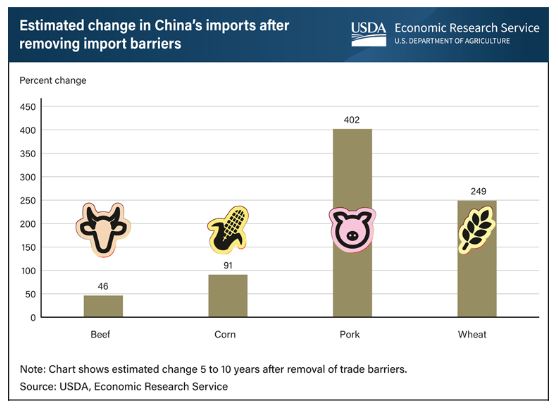Removing China's Domestic Price Trade Barriers: How Would it Impact Ag?

Although China imported more than $205 billion worth of agricultural products in 2021, including more than $37 billion from the U.S., trade barriers deterred China’s imports from reaching even higher levels.
"China’s import barriers create what are called “price wedges,” in which domestic prices for agricultural commodities including beef, corn, pork and wheat are higher than the world price," explains the USDA Economic Research Service (ERS).
Economic theory suggests that a country would import products when foreign prices are lower than domestic prices, decreasing domestic prices and narrowing the “wedge” between domestic and international prices. ERS researchers recently found that removing these price wedges would lead to increases in agricultural imports for the four commodities over the subsequent 5 to 10 years.
- Removal of the corn and wheat price wedges was estimated to increase China’s imports by 91% and 249%, respectively.
Both of these commodities are subject to a tariff-rate quota which could constrain additional imports.
- Removal of the beef price wedge was estimated to increase China’s beef imports by 46%.
- Removal of the pork price wedge was estimated to increase China’s pork imports by 402%.
By far, this is the largest increase among the commodities considered.
Overall, the benefits of removing these trade barriers would be widespread, increasing sales for producers in the U.S. and other exporting countries and yielding lower food prices for China’s consumers, ERS notes.
This chart is drawn from the ERS report China’s Import Potential for Beef, Corn, Pork and Wheat, published in August 2022.
More from Farm Journal's PORK:
The Wild Wild West of Carbon Markets: Where Do Swine Genetics Fit?
When the Reality of the Hunger Problem Hits Close to Home
With Age, I've Gained A Little Perspective








